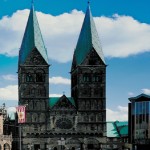Town Hall and Roland on the Marketplace of Bremen
Archaeology »
Heritage sites»
Town Hall and Roland on the Marketplace of Bremen
Location
Bremen
Country
Germany
Year of Research
2004
Culture
The Town Hall and the statue of Roland on the marketplace of Bremen in north-west Germany are outstanding representations of civic autonomy and sovereignty, as these developed in the Holy Roman Empire in Europe. The old town hall was built in the Gothic style in the early 15th century, after Bremen joined the Hanseatic League. The building was renovated in the so-called Weser Renaissance style in the early 17th century. A new town hall was built next to the old one in the early 20th century as part of an ensemble that survived bombardment during the Second World War. The statue stands 5.5 m tall and dates back to 1404.the Bremen Town Hall and Roland bear an exceptional testimony to the civic autonomy and sovereignty, as these developed in the Holy Roman Empire.The Bremen Town Hall and Roland are an outstanding ensemble representing civic autonomy and market freedom. The town hall represents the medieval Saalgeschossbau-type of hall construction, as well as being an outstanding example of the so-called Weser Renaissance in Northern Germany. The Bremen Roland is the most representative and one of the oldest of Roland statues erected as a symbol of market rights and freedom.the ensemble of the town hall and Roland of Bremen with its symbolism is directly associated with the development of the ideas of civic autonomy and market freedom in the Holy Roman Empire. The Bremen Roland is referred to a historical figure, paladin of Charlemagne, who became the source for the French ‘chanson de geste’ and other medieval and Renaissance epic poetry.

